Notes:
[1] Henan No. 1 Work Team of Cultural Relics. Report on the Excavation of Shang Tombs at Baijiazhuang, Zhengzhou City [J]. Reference Materials on Cultural Relics, 1955,(10).
[2] Li Ji. Collected Works of Li Ji [C]. Shanghai: Shanghai People’s Publishing House, 2006.
[3] Guo Baojun. A Survey of Shang and Zhou Bronze Ware [M]. Beijing: Cultural Relics Press, 1981.
[4] [17] See Wang Hong. Study of Shang and Zhou Bronze Lei Vessels [D]. Xi’an: Shaanxi Normal University Press, 2010.
[5] School of Museology, Northwest University & Shaanxi Provincial Cultural Heritage Bureau. Bronze Ware of Chengyang [M]. Beijing: Science Press, 2006.
[6] Guo Yong. Shang Bronze Ware Discovered in the North Suburb of Zhangzi County, Shanxi Province [J]. Reference Materials on Cultural Relics, 1980,(3).
[7] Anyang Work Team of the Institute of Archeology, Chinese Academy of Social Sciences. Two Tombs of the Shang Dynasty to the North of Xiaotun Village in Anyang City [J]. Journal of Archeology, 1981, (4).
[8] Anyang Work Team of Cultural Relics. Tomb No. 269 of Qijiazhuang, Yinxu [J]. Journal of Archeology, 1991, (3).
[9] Beidong Cultural Relics Excavation Team. Shang and Zhou Bronze Ware Unearthed at Beidong Village, Kazuo County, Liaoning Province [J]. Archeology, 1971, (6).
[10]. Cao Mingtan, Shang Zhiru. Western Zhou Bronze Ware Unearthed in Fengxiang County, Shaanxi Province [J]. Archeology & Cultural Relics, 1984, (1).
[11]. Henan Museum & National Museum of History (Taipei). Tomb I & II of Liulige, Huixian County [M]. Zhengzhou: Elephant Press, 2011.
[12]. Zhenjiang Municipal Museum. Eastern Zhou Bronze Ware Unearthed in Dantu County, Jiangsu Province [J]. Archeology, 1981, (5).
[13] Wang Xiantang (late). Study of Pi Bo Lei [J]. Journal of Archeology, 1963, (2).
[14] Anyang Work Team of the Institute of Archeology, Chinese Academy of Social Sciences. Tomb No. 26 to the Southeast of Guojiazhuang Village, Anyang City, Henan Province [J]. Archeology, 1998, (10).
[15] Shaanxi Zhouyuan Work Team of Archeology. Brief on the Excavation of Storage Pit No. 1 of Western Zhou Bronze Ware at Zhuangbai, Fufeng County, Shaanxi Province [J]. Archeology, 1978, (3).
[16] Luoyang Municipal Work Team of Archeology. Western Zhou Tombs of Beiyao, Luoyang City [M]. Beijing: Cultural Relics Press, 1999.
1. Are the three tortoise motifs seen on the neck of the bronze lei with animal-mask motif—as researchers' varying opinions suggest—the totem of a tribe or an early pictographic Chinese character?
2. There are three cross-shaped holes evenly distributed in the ring foot of the bronze lei with animal-mask motif. They are very common in ring-footed bronze ware made in the early and mid Shang Dynasty. Are these holes purely decorative, or do they have other functions?
Your answer please, if you have any questions or answer, please fell free to send us email, we are waiting for your answer and participation, and your comments or answers will be highly appreciated. We will select and publicize the most appropriate answers and comments in the proper time.
Weekly Selection Email: meizhouyipin@chnmus.net
The bronze lei (Image 3) belonging to the upper-stratum period of Erligang Culture, unearthed in 1980 at Longtou Town, Chenggu County, Shaanxi Province. Total height: 37.8cm; mouth diameter: 23.0cm. [5]
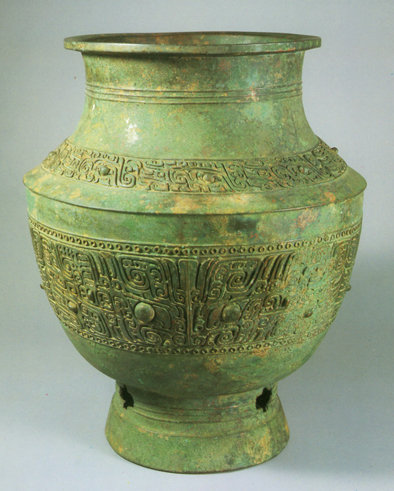
Image 3
The bronze lei belonging to Phase 1 of the Yin Ruins Culture (Image 4), unearthed in 1971 in the north suburb of Zhangzi County, Shanxi Province. Total height: 26cm; mouth diameter: 18cm, [6]
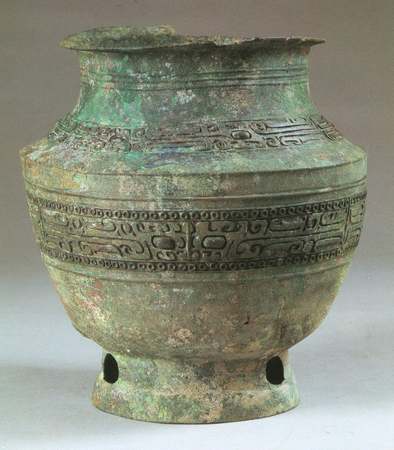
Image 4
The bronze lei (image 5), unearthed in 1977 at Tomb M18 of Phase 2 of the Yin Ruins Culture to the north of Xiaotun Village, Anyang City, Henan Province. Total height: 33cm; mouth diameter: 11.6cm. [7]
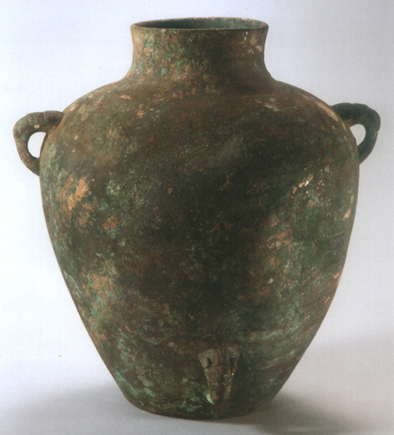
Image 5
The bronze lei (Image 6) belonging to Phase 3 of the Yin Ruins Culture, unearthed in 1984 at Bomb No. 269 to the east of Qijiazhuang Village, Yinxu, Anyang City, Henan Province. Height: 38.6cm; mouth diameter: 16.9cm [8]
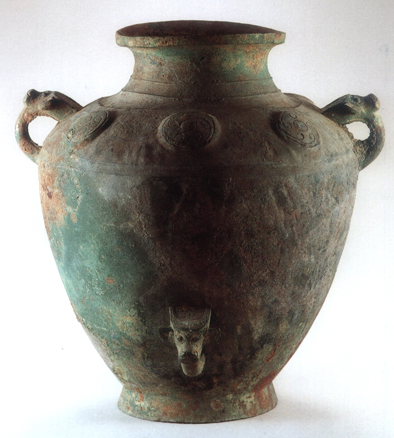
Image 6
The bronze lei (Image 7) of the late Shang and early Zhou Dynasty, unearthed in 1973 from a storage pit at Beidong Village, Kazuo County, Liaoning Province. Total height: 44.5cm; mouth diameter: 16.5cm. [9]

Image 7
The bronze lei of the mid Western Zhou Dynasty (Image 7), unearthed in 1973 at Tianjiazhuang Commune, Fengxiang County, Shaanxi Province. Total height: 46cm; mouth diameter: 23cm; belly depth: 38.5cm. [10]
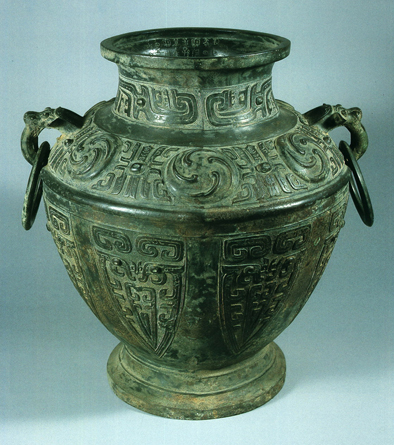
Image 8
One of the two bronze lei vessels of the late Spring and Autumn Period (Image 9), unearthed in 1936 in Tomb I at Liulige, Huixian County, Henan Province. The two are of the same shape and motifs. Z(I)-17:1; total height: 30.5cm; mouth diameter: 21cm. [11]
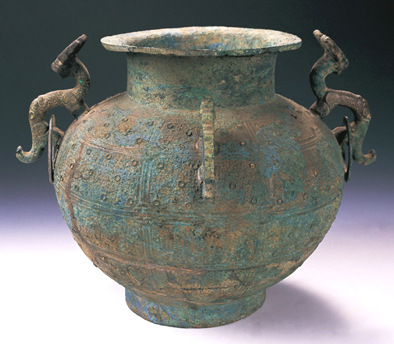
Image 9
The bronze lei of the early Warring States Period (Image 10), unearthed in 1979 in Liangshan at Jianbi, Dantu County, Jiangsu Province. Total height: 39.3cm. [12]
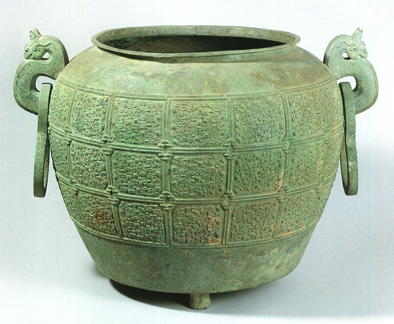
Image 10
One of the two bronze lei vessels of the early Warring States Period (Image 11), collected by the Yixian County Culture Center of Shandong Province in 1954. Total height: 28.5cm; mouth diameter: 21.3cm. [13]
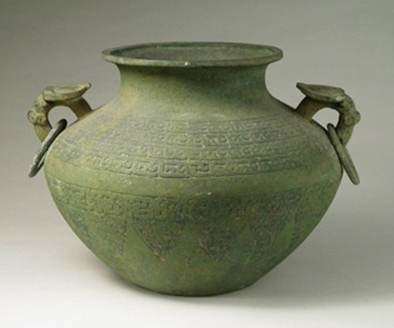
Image 11
The bronze lei with a square mouth belonging to Phase 2 of the Yin Ruins Culture (Image 12), unearthed in 1995 at Tomb No. 26 at Guojiazhuang Village, Anyang City, Henan Province. Height: 38.6cm; mouth size: 15.1cmX12.5cm. [14]
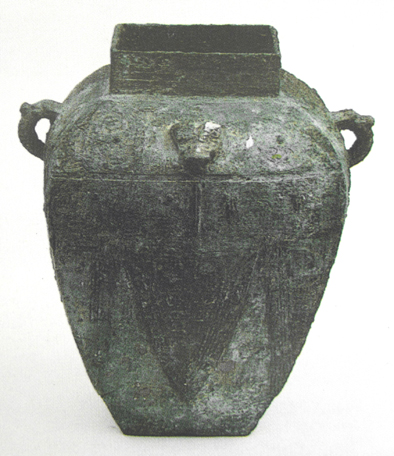
Image 12
The bronze lei of the early Western Zhou Dynasty (Image 13), unearthed in 1976 from Storage Pit No. 1 at Zhuangbai, Fufeng County, Shaanxi Province. Total height: 38cm; belly depth: 33cm. [15]
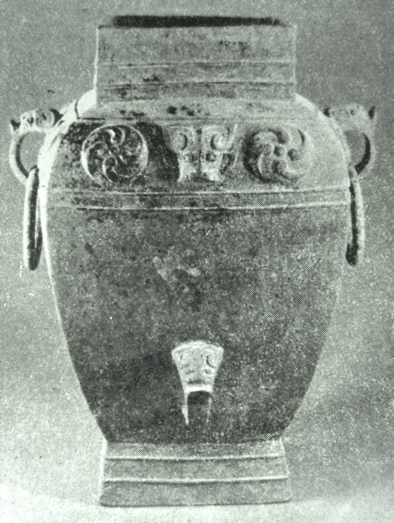
Image 13
The bronze lei with a square mouth made in the early Western Zhou Dynasty (Image 14), unearthed in 1963 from Tomb M6 at Beiyao, Luoyang City, Henan Province. Total height: 50.3cm; mouth size: 13.8cmX13cm. [16]
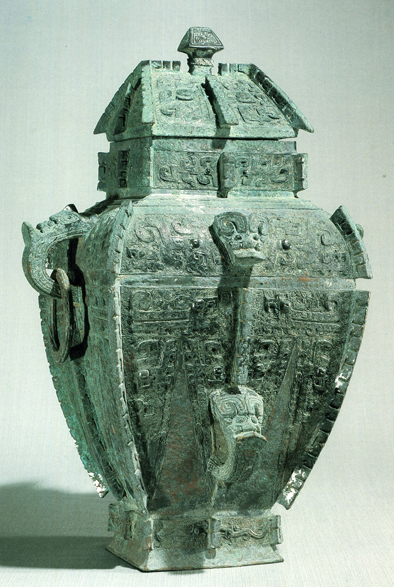
Image 14
As studies on Shang and Zhou bronze lei vessels handed down and unearthed have shown, they had gone through three periods in evolution: first, the period when the earless lei with bent shoulders was prevalent. The vast majority of lei vessels made in this period are lidless and earless and have a broad mouth, a narrow rim, bent shoulders, a high ring foot and openwork patterns. They appeared in the upper-stratum period of Erligang Culture; after Phase 1 of the Yin Ruins Culture, they lost prevalence in the Central Plains region but prospered in the Yangtze River Basin. The second period saw the prevalence of high-bodied round and square lei vessels. Whether in the Central Plains region or in its surrounding areas, bronze lei vessels made in this period are characterized by regular shape, unified form and predictable evolution: they are either lidded or lidless; they feature a small mouth, round shoulders, two ears, and a belly gradually tapering into a foot. In most cases, there are knobs on the upper part of the belly; their ring feet have shown a trend of increasing height; and the holes in the ring feet gradually disappear. The bronze round lei and the bronze lei with a square mouth appeared almost at the same time in the late Shang Dynasty. The square lei, or to be exact, the lei with a square mouth gradually disappeared after the early Western Zhou Dynasty; while the high-bodied round lei gradually declined after the mid Western Zhou Dynasty. The third period saw the popularity of broad-bodied round lei vessels. Bronze lei vessels made in this period are characterized by varying shapes and unpredictable features. They appeared in the mid and late Spring & Autumn Period and disappeared after the early Warring States Period. [17]
As recorded, the lei is a large-sized pot-shaped bronze vessel featuring motifs such as clouds and thunder on the surface. It may have different names corresponding to its different uses.
The association between the name recorded in documents and the material vessel it signifies was established by bronze inscription researchers in the Song Dynasty. However, the names of many material vessels vary from those of vessels of the same kinds in modern times. There remain different opinions as to the naming of lei-shaped vessels. The difference lies mainly in whether the earless lei with bent shoulders belongs to the category of lei. In Chinese Bronze by Ma Chengyuan, it is excluded from the category; but in A General Survey of Chinese Bronze by Zhu Fenghan, it is included. We agree with Zhu. Besides the earless lei with bent shoulders, other lei vessels may be roughly classified into two types: round lei and square lei.
The lei was a bronze ritual vessel containing wine or water in the Shang and Zhou Dynasties. As archeological discoveries have revealed, in and before the Western Zhou Dynasty, it had been interred with the dead chiefly as a wine vessel. In the Eastern Zhou Dynasty, it was used as a water container. There have been many records on its use as a wine vessel. For example, as written in The Rites of Zhou, ‘Great lei vessels have been used at sacrificial ceremonies.’ Erya says, ‘…At sacrificial ceremonies, the yi vessel is always used when wine is poured onto the ground (the guan rite); the zun vessel is used when sacrifices are offered (the xian rite); and the lei vessel is used when wine is offered (the zuo rite)…’ There have also been records on the use of the lei as a water container. For example, according to Rites of Yan VI, Yili (Ceremonies & Rites), ‘…place a xi vessel and a fei vessel to the southeast of the east steps, under the east eaves. The lei with water is to the east; the fei is to the west of the xi…’ As recorded in Offering Hogs & Sheep XVI, Yili, ‘…the Palace Attendant (Si Gong) places the lei with water to the east of the xi. The dou vessel is also used...’
As for the practical use of bronze lei vessels, it should be approached in a comprehensive manner in light of classes of tombs where they were unearthed, the combinations of bronze objects interred, the positions of bronze lei vessels in the tombs, etc. As archeological investigation has turned out, when bronze lei vessel were unearthed at Shang tombs, they are mostly placed together with wine vessels. In tombs later than the mid Western Zhou Dynasty, the number of wine vessels has decreased, and bronze lei vessels have been placed together with water containers, though the positional relations between them do not seem to be very close. The lei vessel that can be definitely classified into the category of water vessel was unearthed from Prince Zheng’s Tomb in Xinzheng with the xi vessel. That is to say, the lei began to be used as a water vessel no later than the mid and late Spring and Autumn Period.
On May 4, 1955, the bronze lei with animal-mask motif was discovered by villagers of Baijiazhuang during a dredging project. It was an item belonging to a Shang Dynasty tomb C8M2[1].
Appearance: The bronze lei with animal-mask motif features a converging mouth with a rim bent outward, a long slender neck, bent shoulders, and a plump belly that tapers at a high, ring foot (Image 1).
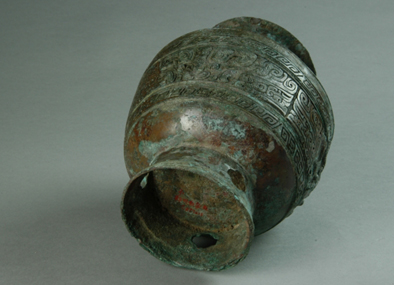
Motifs: The upper part of the neck is decorated with three bands of raised string patterns, under which there are three evenly-distributed tortoise motifs (Image 2); At the joint between the shoulder and neck, there was a band of slanting clouds & thunder pattern; the decorative motifs at the belly consist of one wide band of animal-mask motifs sandwiched by two narrow bands of clouds & thunder motifs; the upper part of the ring foot is ornamented with two bands of raised string patterns, interrupted by three evenly-distributed cross-shaped holes.

Significance of the discovery of the bronze lei with animal-mask motif:
First of all, though the bronze lei with animal-mask motif was discovered by ordinary people, it can be assured that it belonged to an ancient tomb. Thus it fits into the category of properly unearthed cultural relics. Made in the late upper-stratum period of Erligang Culture, i.e. the early mid Shang Dynasty, it is the earliest bronze lei properly unearthed so far. Its discovery has not only increased China’s small collection of bronze objects made in the early and mid Shang Dynasty, but also provided basis for the studies on and dating of bronze lei in that period.
Secondly, the belly of the bronze lei with animal-mask motif bears clear traces of the chinks of the composite mould. All the mould trace lines ran through the three cross-shaped holes. This feature is of great value for studies on the use of holes in the ring foot of early bronze ware; and the bronze lei is an important object for studies on early bronze ware moulds. The animal mask motifs on its belly are made in micro relief, highlighting all the different parts. Such animal-mask motifs are very rare on early and mid Shang bronze vessels. This bronze vessel not only represents the achievements made by the Chinese in bronze casting then, but also shows the primitive form of the ‘three-layers-of-motifs’ technique that appeared in the late Shang Dynasty.
Besides, after the bronze lei with animal-mask motif were unearthed, the three evenly-distributed tortoise motifs on the neck have attracted wide attention from academic circles. Such decorative motifs are very rare on early and mid Shang bronze objects. Most scholars believe that the tortoise might have been the totem of a tribe, whereas others interpret them as the pictographic character for ‘min’ (黾) or ‘gui’ (龜). If the latter is right, the motifs may be regarded as the earliest bronze inscription ever discovered in China.
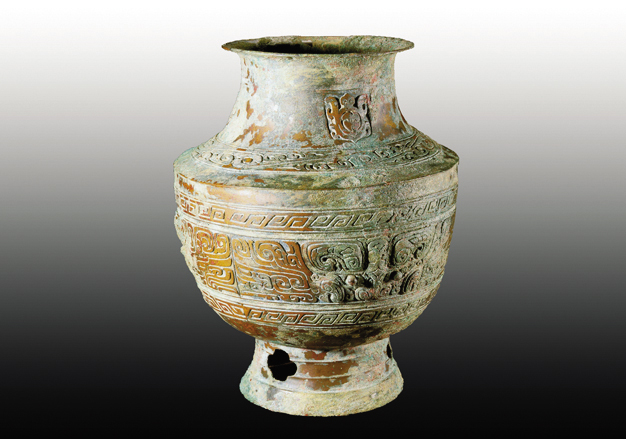
Item name:Bronze Lei with Animal-Mask Motif
Category: Bronze ware,
Period: Shang dynasty,
Measurements: 24.5 cm high, 13 cm in mouth diameter.
Location: unearthed at No.2 tomb at the village of Baijiazhuang in 1955

Zhang Junru, Graduate of Jilin University, majoring in museology. Researcher of the Collections Administration Department, specialized in the study and authentication of the Bronzewares of Xia and Shang dynasty.

Si Xiulin, univercity degree, with a intermediate title, and vice director of the Head office of Henan Museum